Effects of Antecedent Precipitation Amount and COVID-19 Lockdown on Water Quality along an Urban Gradient
Abstract
1. Introduction
- To observe whether the study area experiences different levels of pollutants between seasons and COVID-19 lockdown period.
- To identify the relationship between pollutant concentration and precipitation and landscape variables in the urban environment.
- To quantify the Random Forest model’s ability to model water quality compared to OLS.
2. Materials and Methods
2.1. Study Area
2.2. Data Preparation
2.3. Methodology
3. Results
3.1. Seasonal Differences in Water Quality
3.2. Effects of COVID-19 Lockdown on Water Quality
3.3. Correlation between Water Quality and Explanatory Variables
3.4. Random Forest Regression Results
4. Discussion
5. Conclusions
Author Contributions
Funding
Data Availability Statement
Acknowledgments
Conflicts of Interest
References
- Chen, H.J.; Chang, H. Response of discharge, TSS, and E. coli to rainfall events in urban, suburban, and rural watersheds. Environ. Sci. Process. Impacts 2014, 16, 2313–2324. [Google Scholar] [CrossRef] [PubMed]
- Dwight, R.H.; Caplan, J.S.; Brinks, M.V.; Catlin, S.N.; Buescher, G.; Semenza, J.C. Influence of Variable Precipitation on Coastal Water Quality in Southern California. Water Environ. Res. 2011, 83, 2121–2130. [Google Scholar] [CrossRef] [PubMed]
- Fish, N.; Jordan, M. Portland Area Watershed Monitoring and Assessment Program. Executive Summary—Findings from Years 1–4. 2018. Available online: https://www.portlandoregon.gov/bes/article/689921 (accessed on 27 July 2021).
- Yazdi, M.N.; Sample, D.J.; Scott, D.; Wang, X.; Ketabchy, M. The effects of land use characteristics on urban stormwater quality and watershed pollutant loads. Sci. Total Environ. 2021, 773, 145358. [Google Scholar] [CrossRef] [PubMed]
- Guo, D.; Lintern, A.; Webb, J.A.; Ryu, D.; Liu, S.; Bende-Michl, U.; Leahy, P.; Wilson, P.; Western, A.W. Key Factors Affecting Temporal Variability in Stream Water Quality. Water Resour. Res. 2019, 55, 112–129. [Google Scholar] [CrossRef]
- Ferreira, C.S.S.; Walsh, R.P.D.; de Lourdes Costa, M.; Coelho, C.O.A.; Ferreira, A.J.D. Dynamics of surface water quality driven by distinct urbanization patterns and storms in a Portuguese peri-urban catchment. J. Soils Sediments 2016, 16, 2606–2621. [Google Scholar] [CrossRef]
- Ortiz-Hernández, J.; Lucho-Constantino, C.; Lizárraga-Mendiola, L.; Beltrán-Hernández, R.I.; Coronel-Olivares, C.; Vázquez-Rodríguez, G. Quality of urban runoff in wet and dry seasons: A case study in a semi-arid zone. Environ. Sci. Pollut. Res. 2016, 23, 25156–25168. [Google Scholar] [CrossRef] [PubMed]
- Mainali, J.; Chang, H.; Chun, Y. A review of spatial statistical approaches to modeling water quality. Prog. Phys. Geogr. Earth Environ. 2019, 43, 801–826. [Google Scholar] [CrossRef]
- Oregon Department of Transportation. TRAFFIC FLOW MAP 2020 [WWW Document]. Flow_Map_2020. 2020. Available online: https://www.oregon.gov/odot/Data/Documents/Flow_Map_2020.pdf (accessed on 30 July 2021).
- Oregon Department of Transportation. Impacts of COVID-19 on Traffic [WWW Document]. Region1 Covid-19 Traffic Report 20 08.03.20-09.23.20. 2021. Available online: https://www.oregon.gov/odot/Projects/Project%20Documents/Region1%20Covid-19%20Traffic%20Report%2020%2008.03.20-09.23.20.pdf (accessed on 30 July 2021).
- Beasley, G.; Kneale, P. Reviewing the impact of metals and PAHs on macroinvertebrates in urban watercourses. Prog. Phys. Geogr. Earth Environ. 2002, 26, 236–270. [Google Scholar] [CrossRef]
- Alexakis, D.E. Multielement Contamination of Land in the Margin of Highways. Land 2021, 10, 230. [Google Scholar] [CrossRef]
- Sansalone, J.J.; Buchberger, S.G. Partitioning and First Flush of Metals in Urban Roadway Storm Water. J. Environ. Eng. 1997, 123, 134–143. [Google Scholar] [CrossRef]
- Andoh, R.Y.G. Urban Runoff: Nature, Characteristics and Control. Water Environ. J. 1994, 8, 371–378. [Google Scholar] [CrossRef]
- Marsalek, J.; Rochfort, Q.; Brownlee, B.; Mayer, T.; Servos, M. An exploratory study of urban runoff toxicity. Water Sci. Technol. 1999, 39, 33–39. [Google Scholar] [CrossRef]
- Arefinia, A.; Bozorg-Haddad, O.; Chang, H. Chapter 4: The Role of Data Mining in Water Resources Management. In Essential Tools for Water Resources Analysis, Planning, and Management; Bozorg-Haddad, O., Ed.; Springer: Singapore, 2021. [Google Scholar]
- Nourani, V.; Molajou, A.; Tajbakhsh, A.D.; Najafi, H. A Wavelet Based Data Mining Technique for Suspended Sediment Load Modeling. Water Resour. Manag. 2019, 33, 1769–1784. [Google Scholar] [CrossRef]
- Wang, F.; Wang, Y.; Zhang, K.; Hu, M.; Weng, Q.; Zhang, H. Spatial heterogeneity modeling of water quality based on random forest regression and model interpretation. Environ. Res. 2021, 202, 111660. [Google Scholar] [CrossRef]
- Sakaa, B.; Elbeltagi, A.; Boudibi, S.; Chaffaï, H.; Islam, A.R.M.T.; Kulimushi, L.C.; Choudhari, P.; Hani, A.; Brouziyne, Y.; Wong, Y.J. Water quality index modeling using random forest and improved SMO algorithm for support vector machine in Saf-Saf river basin. Environ. Sci. Pollut. Res. 2022, 29, 48491–48508. [Google Scholar] [CrossRef]
- Chang, H. Comparative streamflow characteristics in urbanizing basins in the Portland Metropolitan Area, Oregon, USA. Hydrol. Process. 2007, 21, 211–222. [Google Scholar] [CrossRef]
- United States Geological Survey, 2021. City of Portland HYDRA Rainfall Network. Available online: https://or.water.usgs.gov/non-usgs/bes/ (accessed on 28 June 2021).
- City of Portland Environmental Services, n.d. Portland Area Watershed Monitoring and Assessment Program (PAWMAP). Available online: https://www.portlandoregon.gov/bes/article/489038 (accessed on 28 June 2021).
- Cooley, A.K.; Chang, H. Detecting change in precipitation indices using observed (1977–2016) and modeled future climate data in Portland, Oregon, USA. J. Water Clim. Change 2021, 12, 1135–1153. [Google Scholar] [CrossRef]
- McKinney, W. Data Structures for Statistical Computing in Python. In Proceedings of the 9th Python in Science Conference, Austin, TX, USA, 28 June–3 July 2010; Available online: https://conference.scipy.org/proceedings/scipy2010/pdfs/mckinney.pdf (accessed on 28 June 2021).
- Gelsey, K.; Chang, H.; Ramirez, D. Effects of Landscape Characteristics, Anthropogenic Factors, and Seasonality on Water Quality in Portland, Oregon; Portland State University: Portland, OR, USA, 2021. (In review) [Google Scholar]
- Breiman, L. Random Forest. Mach. Learn. 2001, 45, 5–32. [Google Scholar] [CrossRef]
- Pedregosa, F.; Varoquaux, G.; Gramfort, A.; Michel, V.; Thirion, B.; Grisel, O.; Blondel, M.; Prettenhofer, P.; Weiss, R.; Dubourg, V.; et al. Scikit-learn: Machine Learning in Python. J. Mach. Learn. Res. 2011, 12, 2825–2830. [Google Scholar]
- Sonoda, K.; Yeakley, J.A. Relative Effects of Land Use and Near-Stream Chemistry on Phosphorus in an Urban Stream. J. Environ. Qual. 2007, 36, 144–154. [Google Scholar] [CrossRef]
- Yang, Y.-Y.; Toor, G.S. Stormwater runoff driven phosphorus transport in an urban residential catchment: Implications for protecting water quality in urban watersheds. Sci. Rep. 2018, 8, 11681. [Google Scholar] [CrossRef] [PubMed]
- Hobbiea, S.E.; Finlaya, J.S.; Jankea, B.D.; Nidzgorskia, D.A.; Milletb, D.B.; Baker, L.A. Contrasting nitrogen and phosphorus budgets in urban watersheds and implications for managing urban water pollution. Proc. Natl. Acad. Sci. USA 2017, 114, 4177–4182. [Google Scholar] [CrossRef] [PubMed]
- Huang, J.Y.; Gergel, S.E. Landscape indicators as a tool for explaining heavy metal concentrations in urban streams. Landsc. Urban Plan. 2022, 220, 104331. [Google Scholar] [CrossRef]
- Wetz, M.S.; Powers, N.C.; Turner, J.W.; Huang, Y. No widespread signature of the COVID-19 quarantine period on water quality across a spectrum of coastal systems in the United States of America. Sci. Total Environ. 2022, 807, 150825. [Google Scholar] [CrossRef] [PubMed]
- Chen, H.; Huo, J.; Fu, Q.; Duan, Y.; Xiao, H.; Chen, J. Impact of quarantine measures on chemical compositions of PM2.5 during the COVID-19 epidemic in Shanghai, China. Sci. Total Environ. 2020, 743, 140758. [Google Scholar] [CrossRef]
- Yang, Y.; Zhao, T.; Jiao, H.; Wu, L.; Xiao, C.; Guo, X.; Jin, C. Atmospheric Organic Nitrogen Deposition in Strategic Water Sources of China after COVID-19 Lockdown. Int. J. Environ. Res. Public Health 2022, 19, 2734. [Google Scholar] [CrossRef]
- Bamney, A.; Gupta, N.; Jashami, H.; Megat-Johari, M.-U.; Savolainen, P. An Analysis of Changes in County-Level Travel Behavior Considering COVID-19–Related Travel Restrictions, Immunization Patterns, and Political Leanings. J. Transp. Eng. Part A Syst. 2022, 148, 04022096. [Google Scholar] [CrossRef]
- Hamilton, J.L.; Luffman, I. Precipitation, pathogens, and turbidity trends in the Little River, Tennessee. Phys. Geogr. 2009, 30, 236–248. [Google Scholar] [CrossRef]
- McCurdy, P.; Luffman, I.; Joyner, T.A.; Maier, K. Storm sampling to assess inclement weather impacts on water quality in a karst watershed: Sinking Creek, Watauga watershed, East Tennessee. J. Environ. Qual. 2021, 50, 429–440. [Google Scholar] [CrossRef]
- Chang, H.; Makido, Y.; Foster, E. Effects of land use change, wetland fragmentation, and best management practices on total suspended solids concentrations in an urbanizing Oregon watershed, USA. J. Environ. Manag. 2021, 282, 111962. [Google Scholar] [CrossRef]
- Fletcher, T.; Andrieu, H.; Hamel, P. Understanding, management and modelling of urban hydrology and its consequences for receiving waters: A state of the art. Adv. Water Resour. 2003, 51, 261–279. [Google Scholar] [CrossRef]
- Shamshirband, S.; Jafari Nodoushan, E.; Adolf, J.E.; Abdul Manaf, A.; Mosavi, A.; Chau, K.W. Ensemble models with uncertainty analysis for multi-day ahead forecasting of chlorophyll a concentration in coastal waters. Eng. Appl. Comput. Fluid Mech. 2019, 13, 91–101. [Google Scholar] [CrossRef]
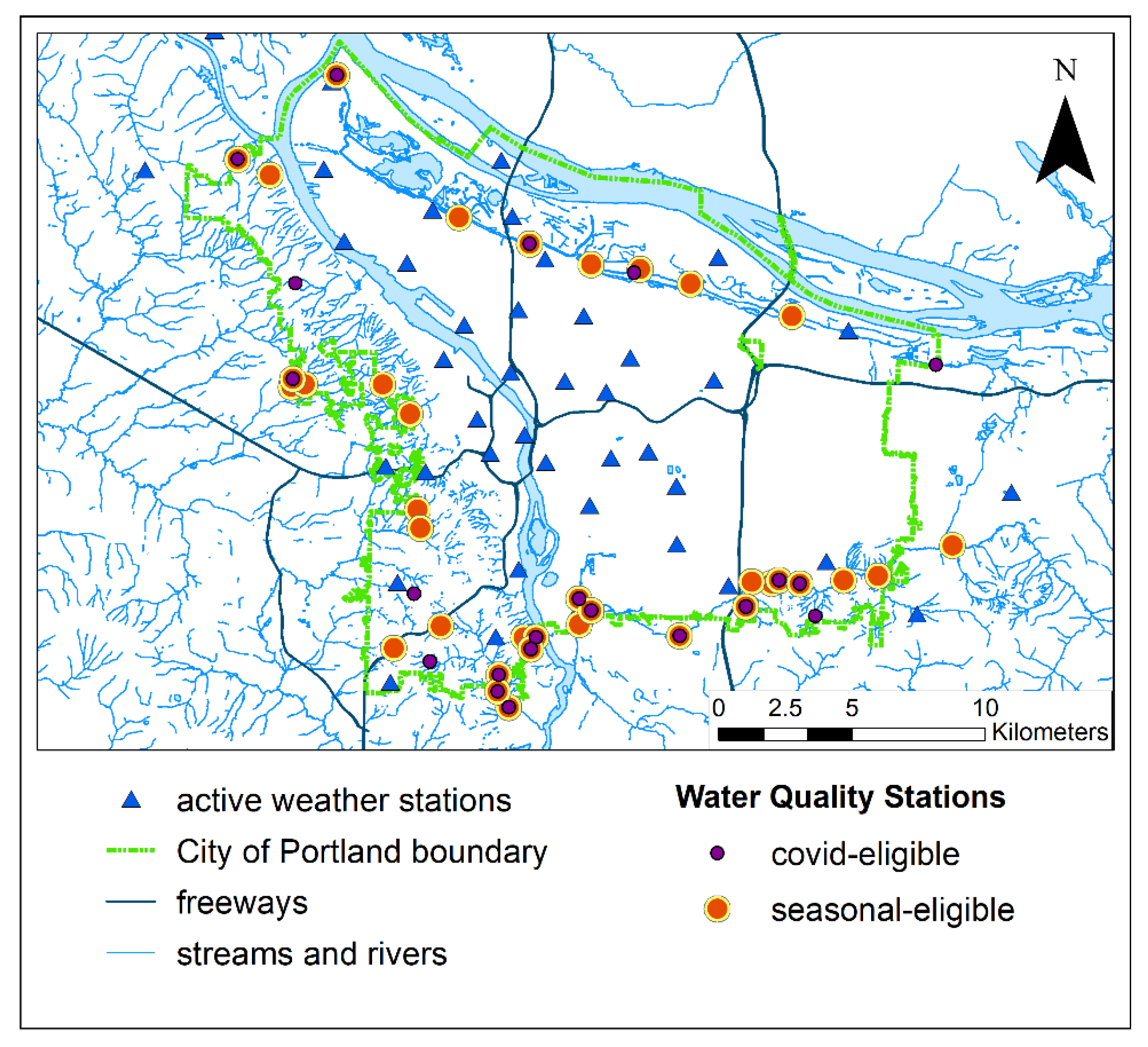

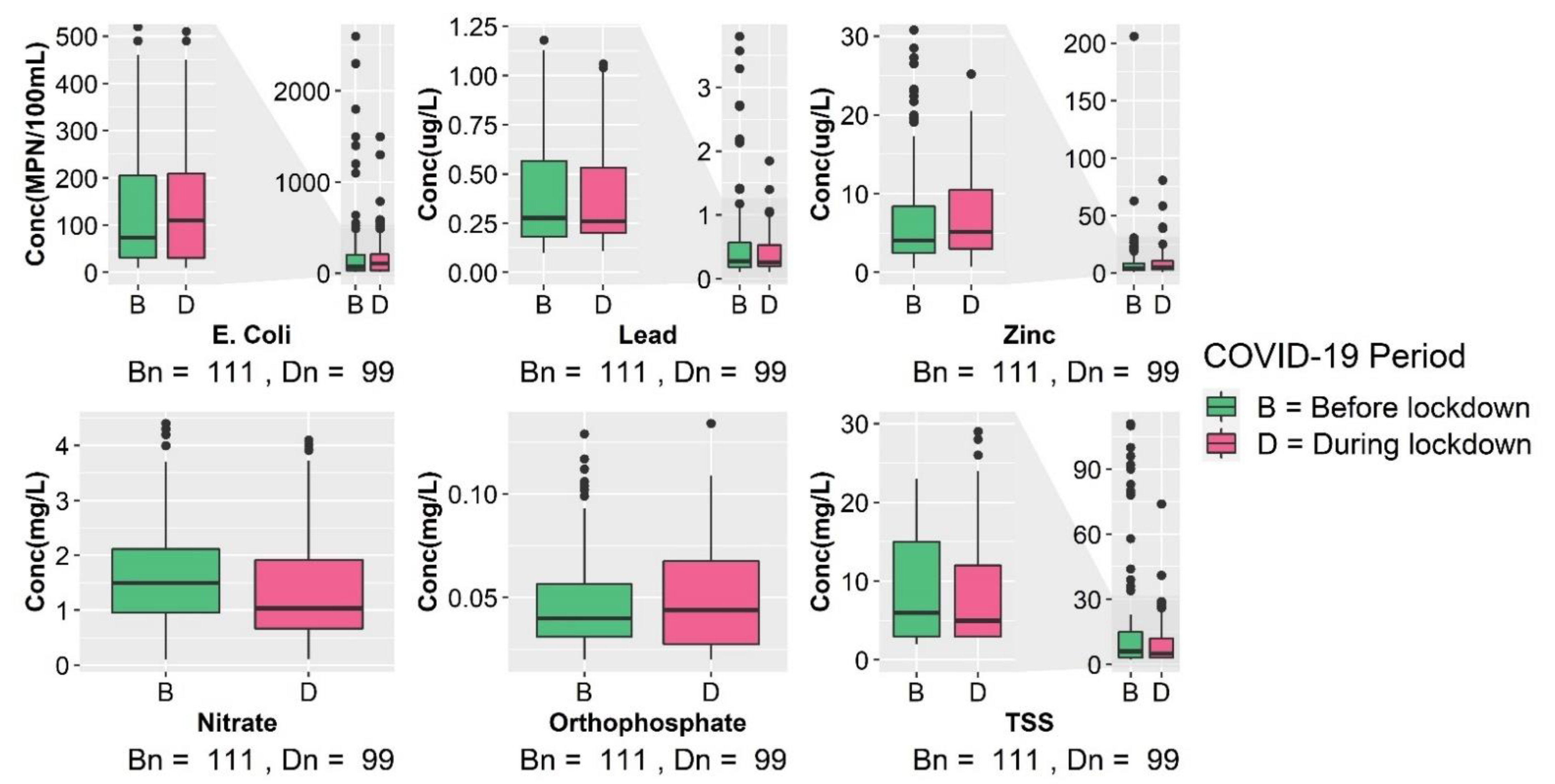
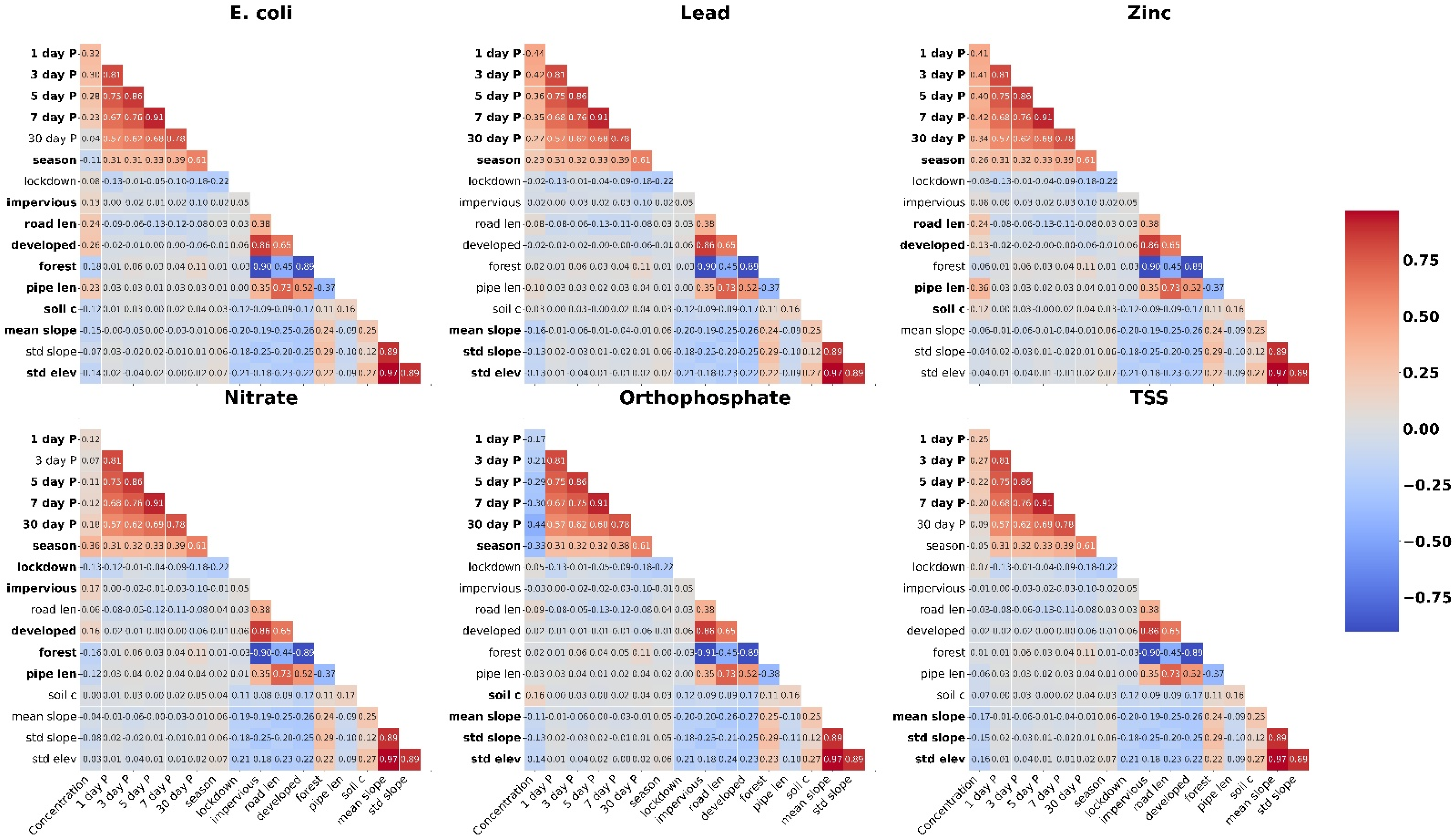
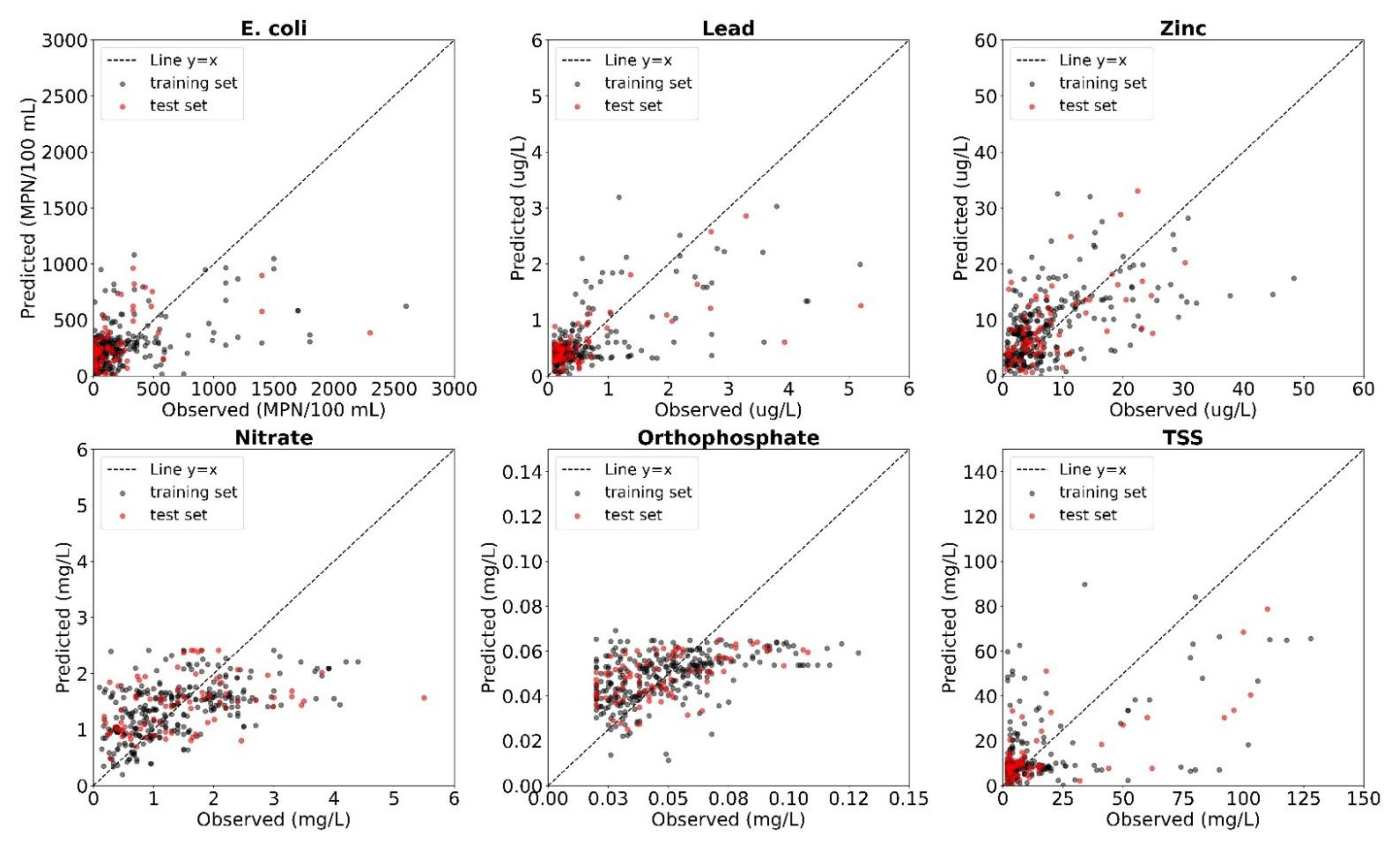
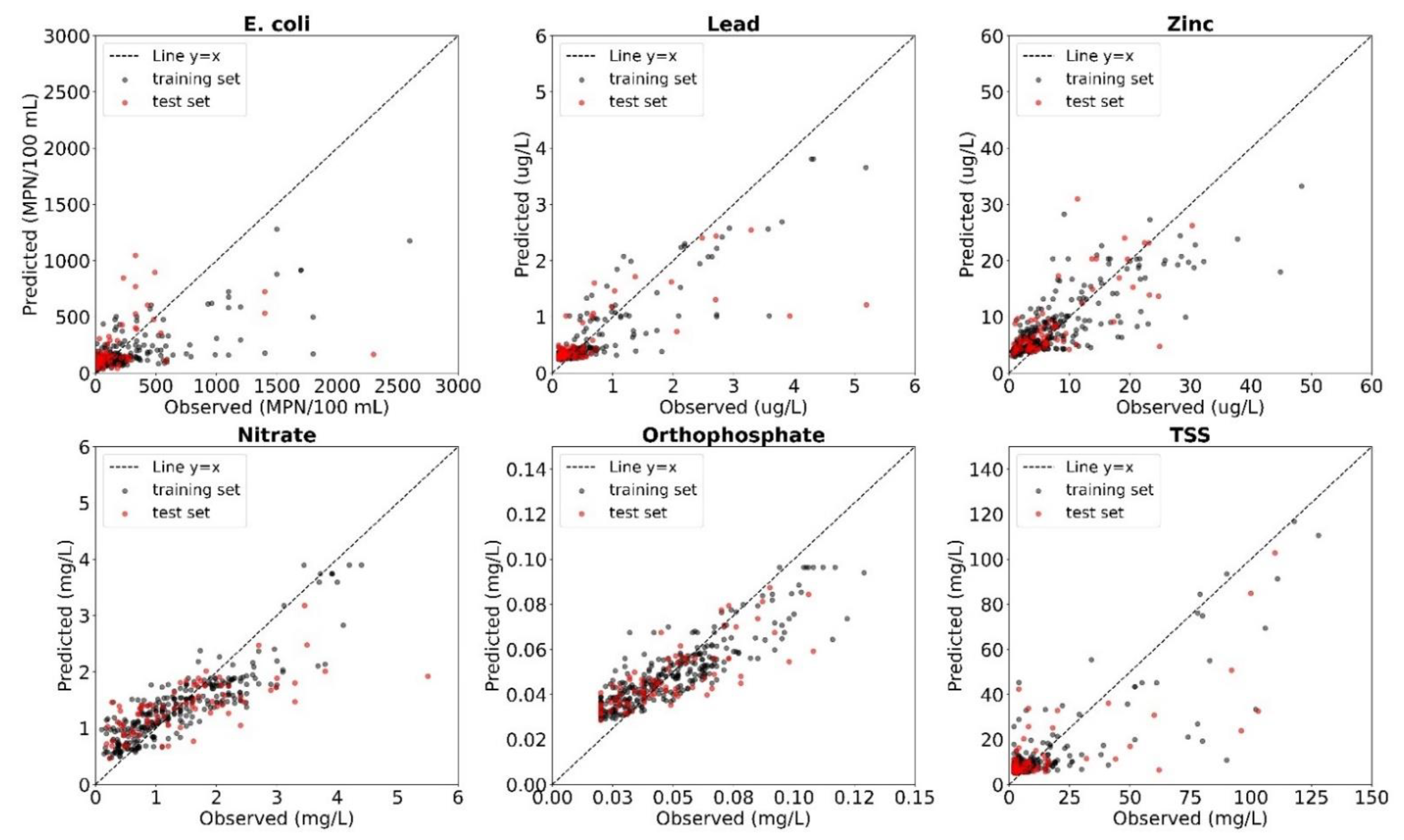
| Pollutant (Units) | Dry Season Samples | Wet Season Samples | Dry Season Median Concentration | Wet Season Median Concentration | Mann–Whitney p-Value |
|---|---|---|---|---|---|
| E. coli (MPN/100 mL) | 141 | 236 | 120 | 85.0 | 0.0029 |
| Lead (μg/L) | 141 | 236 | 0.224 | 0.315 | <0.001 |
| Zinc (μg/L) | 141 | 236 | 3.78 | 5.705 | <0.001 |
| TSS (mg/L) | 141 | 236 | 4.0 | 4.0 | 0.351 |
| Nitrate (mg/L) | 143 | 236 | 0.72 | 1.5 | <0.001 |
| Orthophosphate (mg/L) | 142 | 236 | 0.054 | 0.038 | <0.001 |
| Pollutant (Units) | Pre-COVID-19 Samples | COVID-19 Lockdown Samples | Pre-COVID-19 Median Concentration | COVID-19 Lockdown Median Concentration | Mann–Whitney Test p-Value |
|---|---|---|---|---|---|
| E. coli (MPN/100 mL) | 111 | 99 | 74.0 | 110.0 | 0.75 |
| Lead (μg/L) | 111 | 99 | 0.277 | 0.261 | 0.61 |
| Zinc (μg/L) | 111 | 99 | 4.09 | 5.15 | 0.32 |
| TSS (mg/L) | 111 | 99 | 6.0 | 5.0 | 0.93 |
| Nitrate (mg/L) | 111 | 99 | 1.5 | 1.04 | 0.02 |
| Orthophosphate (mg/L) | 111 | 99 | 0.04 | 0.044 | 0.71 |
| OLS | ||||
| Pollutant | RSME | MAE | MAPE | R2 |
| E. coli | 321.09 | 205.26 | 5.20 | 0.149 |
| Lead | 2.11 | 0.57 | 0.97 | 0.042 |
| Nitrate | 0.95 | 0.72 | 0.81 | 0.105 |
| Orthophosphate | 0.00 | 0.015 | 0.39 | 0.29 |
| TSS | 18.21 | 10.87 | 1.23 | 0.499 |
| Zinc | 12.13 | 6.34 | 1.20 | 0.284 |
| Random Forest | ||||
| Pollutant | RSME | MAE | MAPE | R2 |
| E. coli | 323.68 | 159.15 | 2.91 | 0.13 |
| Lead | 2.07 | 0.53 | 0.77 | 0.08 |
| Nitrate | 0.77 | 0.55 | 0.62 | 0.42 |
| Orthophosphate | 0.00 | 0.01 | 0.25 | 0.58 |
| TSS | 17.35 | 9.52 | 1.16 | 0.54 |
| Zinc | 11.35 | 4.97 | 0.93 | 0.37 |
Publisher’s Note: MDPI stays neutral with regard to jurisdictional claims in published maps and institutional affiliations. |
© 2022 by the authors. Licensee MDPI, Basel, Switzerland. This article is an open access article distributed under the terms and conditions of the Creative Commons Attribution (CC BY) license (https://creativecommons.org/licenses/by/4.0/).
Share and Cite
Ramirez, D.; Chang, H.; Gelsey, K. Effects of Antecedent Precipitation Amount and COVID-19 Lockdown on Water Quality along an Urban Gradient. Hydrology 2022, 9, 220. https://doi.org/10.3390/hydrology9120220
Ramirez D, Chang H, Gelsey K. Effects of Antecedent Precipitation Amount and COVID-19 Lockdown on Water Quality along an Urban Gradient. Hydrology. 2022; 9(12):220. https://doi.org/10.3390/hydrology9120220
Chicago/Turabian StyleRamirez, Daniel, Heejun Chang, and Katherine Gelsey. 2022. "Effects of Antecedent Precipitation Amount and COVID-19 Lockdown on Water Quality along an Urban Gradient" Hydrology 9, no. 12: 220. https://doi.org/10.3390/hydrology9120220
APA StyleRamirez, D., Chang, H., & Gelsey, K. (2022). Effects of Antecedent Precipitation Amount and COVID-19 Lockdown on Water Quality along an Urban Gradient. Hydrology, 9(12), 220. https://doi.org/10.3390/hydrology9120220







